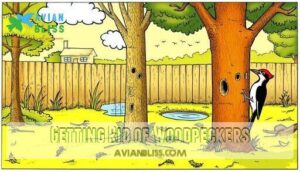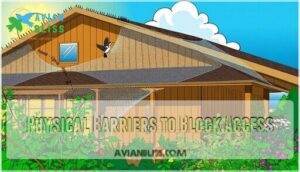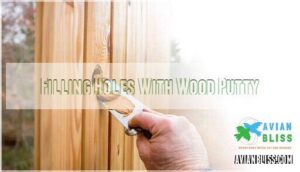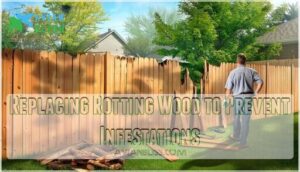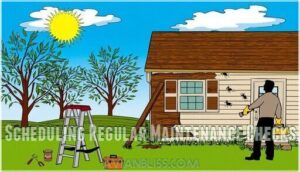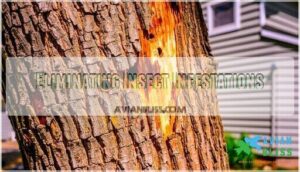This site is supported by our readers. We may earn a commission, at no cost to you, if you purchase through links.
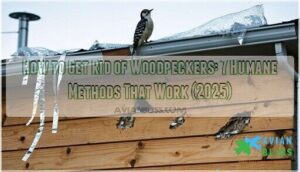 You can get rid of woodpeckers using humane deterrent methods that address their motivations.
You can get rid of woodpeckers using humane deterrent methods that address their motivations.
Start by eliminating insect infestations—the primary reason they’re pecking your siding in the first place.
Install visual deterrents like reflective tape, hanging shiny objects, or predator decoys near damaged areas.
Physical barriers such as netting or hardware cloth block access to favorite spots.
Noise-making devices and regular disruption discourage territorial drumming.
Repair existing damage with wood putty and replace rotting sections that attract insects.
Understanding their behavior patterns helps you target the right solutions effectively.
Table Of Contents
- Key Takeaways
- Woodpecker Behavior Patterns
- Getting Rid of Woodpeckers
- Humane Deterrent Strategies
- Repairing Woodpecker Damage
- Preventing Future Infestations
- Frequently Asked Questions (FAQs)
- How do you get a woodpecker to leave?
- What is the most effective woodpecker deterrent?
- How do exterminators get rid of woodpeckers?
- Why are woodpeckers pecking my house?
- What smells do woodpeckers hate?
- How do you ward off woodpeckers safely?
- How to stop woodpecker damage to a home?
- Do woodpeckers damage your home?
- How do electronic woodpecker deterrents work?
- How do I permanently get rid of woodpeckers?
- Conclusion
Key Takeaways
- Eliminate their food source first – You’ll solve 90% of woodpecker problems by treating underlying insect infestations in your siding, since they’re not randomly destructive but are following survival instincts to find protein-rich bugs.
- Combine multiple deterrent methods for best results – You can’t rely on just one approach; layer visual deterrents like reflective tape, noise-making devices, and physical barriers like netting to create an unwelcoming environment.
- Address damage immediately to prevent returns – You’ll need to fill holes with exterior-grade wood putty and replace rotting wood sections that attract insects, since existing damage signals "food source here" to other woodpeckers.
- Create alternative feeding areas away from your home – You can redirect their behavior by installing suet feeders and planting berry bushes at least 20 yards from your house, giving them easier meal options elsewhere.
Woodpecker Behavior Patterns
Before you implement woodpecker deterrents, you’ll need to understand their behavior patterns to choose the most effective approach.
Woodpeckers create distinct damage signatures—small, deep holes arranged in vertical or horizontal rows indicate foraging, while larger cavities suggest nesting attempts.
Small holes arranged in rows spell out "woodpecker was here"—nature’s signature left behind after foraging expeditions.
The telltale hammering noise helps you pinpoint their activity zones.
Identifying Pecking Patterns
Looking at your property, hole size tells the story of woodpecker behavior.
Small, deep holes arranged in neat rows indicate foraging for insects, while larger cavities suggest nesting attempts.
Pecking frequency varies with seasonal changes – spring brings intense drumming for mating, while fall increases food-seeking activity.
Sound analysis helps identify the culprit: rapid-fire tapping means feeding, while loud drumming signals territorial behavior.
Damage location patterns on siding damage reveal whether you’re dealing with woodpecker activity patterns focused on food or shelter.
Recognizing Nesting Cavities
Beyond those telltale pecking patterns, you’ll need to spot where woodpeckers actually call home. Nesting holes differ dramatically from simple foraging marks, requiring your detective skills for effective woodpecker control.
Cavity Dimensions reveal the real story. Entrance Size typically measures 1.5-3 inches in diameter, perfectly circular and precisely carved. These openings lead to spacious vertical chambers that extend 6-15 inches deep, creating cozy apartments for raising young.
Active Signs help distinguish occupied from abandoned sites:
- Fresh wood chips scattered below Cavity Location indicate recent excavation
- Nesting Materials like feathers, twigs, or soft debris around entrance holes
- Regular bird traffic with food deliveries during breeding season
- Distinctive drumming sounds echoing from within the cavity
Cavity Location matters tremendously. Woodpeckers choose south or east-facing spots for warmth, targeting areas where sound wood meets softer, partially rotted sections. This strategic placement maximizes both structural integrity and excavation ease, making woodpecker prevention more challenging but not impossible.
Understanding Food Sources
Woodpeckers target your property because it offers what they need most: food. These birds aren’t randomly destructive—they’re following their survival instincts to locate protein-rich insects living beneath your siding, eaves, and trim.
Hungry woodpeckers follow their instincts—your home’s hidden insect buffet makes the perfect dining destination
Here’s what draws them to specific areas:
- Wood-boring beetle larvae hiding in cedar, pine, and composite materials make irresistible snacks
- Carpenter ant colonies nestled behind moisture-damaged boards create woodpecker buffets
- Termite activity within structural wood sends dinner bells ringing for hungry birds
Effective woodpecker control starts with insect removal. When you eliminate the underlying insect infestation, you remove their primary motivation for attacking your home. Consider installing suet feeders and berry bushes as food relocation strategies—alternative planting gives them easier meals elsewhere. These woodpecker deterrents work because they address the root cause rather than just the symptoms of woodpecker damage.
Common Areas for Woodpecker Damage
Woodpeckers target specific areas where building materials offer easy access to insects or nesting opportunities.
These birds focus their attention on wood surfaces that provide the greatest reward for their efforts.
Here are the five most vulnerable spots on your property:
- Siding Damage: Cedar and redwood wood siding attracts woodpeckers seeking insects beneath the surface
- Eaves Soffits: These sheltered areas provide ideal nesting locations and insect access points
- Window Frames: Wooden frames around windows offer soft wood for cavity creation
- Chimneys: Caps and wooden structures provide drumming surfaces and potential nesting sites
- Wooden Structures: Fascia boards, trim, and decking become primary targets for woodpecker holes
Early detection prevents extensive woodpecker damage to these critical areas.
Getting Rid of Woodpeckers
When dealing with persistent woodpeckers, you’ll need a strategic approach that addresses both immediate deterrence and long-term solutions. Start by identifying what attracts them—inspect your property for insect infestations that serve as food sources, since eliminating these removes their primary motivation.
Habitat modification proves highly effective for woodpecker damage control. Replace rotting wood, seal cracks where insects hide, and remove dead trees near your home. These changes make your property less appealing to foraging birds.
For immediate relief, repellent sprays containing methyl anthranilate create an unpleasant taste that discourages pecking without harming the birds. Apply these products to targeted areas following manufacturer instructions.
Professional removal services can assess severe infestations and provide legal options when damage becomes extensive. However, remember that woodpeckers are federally protected, so any intervention must comply with wildlife regulations. One approach involves using effective visual deterrents like reflective tape.
Combining multiple bird deterrents and woodpecker deterrents creates the most thorough approach to stop woodpeckers permanently.
Humane Deterrent Strategies
When woodpeckers target your home, you’ll want to redirect their attention rather than harm these protected birds.
The most effective approach combines multiple humane strategies that exploit woodpeckers’ natural behaviors and sensitivities to create an unwelcoming environment around your property.
Visual Deterrents for Woodpeckers
Visual deterrents leverage reflective materials and moving objects to confuse woodpeckers through unpredictable light patterns. These visual deterrents exploit birds’ natural wariness of threats and shifting environments.
Woodpeckers are federally protected, so utilize humane, non-lethal deterrents.
Try these effective woodpecker deterrents:
- Reflective tape and holographic tape hung near damage sites create dancing light reflections that startle approaching birds
- Shiny objects like old CDs, mirrors, or aluminum pie pans catch sunlight and move with wind currents
- Scare objects including predator balloons with eye patterns trigger avoidance responses in territorial woodpeckers
Position these reflective surfaces within 12-15 feet of pecking sites and rotate placement weekly to prevent habituation.
Noise-Making Devices to Repel Woodpeckers
Deploying electronic repellers and ultrasonic devices creates an acoustic battlefield that woodpeckers can’t ignore.
Wind chimes and DIY noisemakers like metal pans generate unpredictable sound frequencies that interrupt their pecking routines. While loud noises from clapping work temporarily, programmable sonic units play distress calls at ideal intervals.
Combine these noise deterrents with shiny objects for enhanced bird scare tactics—the dual sensory assault proves more effective than sound alone against persistent woodpeckers.
These methods align with humane bird control practices.
Physical Barriers to Block Access
Creating effective barrier materials requires strategic planning.
Install bird netting at least three inches from siding surfaces to prevent pecking through the mesh. Netting installation should cover all vulnerable areas completely, securing edges tightly.
Hardware cloth and metal flashing provide durable siding protection. Bird spikes discourage perching on ledges and trim.
Mesh solutions like ¾-inch birdproof netting offer nearly invisible bird exclusion. Always check for trapped birds before hole covering with barriers.
Consider adding native plants, as they offer essential shelter and nesting opportunities for birds.
Using Reflective Objects to Deter Woodpeckers
Reflective objects create unpredictable light reflection patterns that effectively startle woodpeckers.
Place reflective streamers or mylar holographic tape near damaged areas for maximum impact.
Sunlight amplification increases effectiveness, making aluminum foil strips particularly useful.
Mylar balloons and reflective tape work well with object movement from wind.
Strategic placement strategies involve positioning these deterrents directly facing woodpecker activity zones.
Hanging Shiny Objects to Repel Woodpeckers
Shiny materials work like nature’s alarm system – they get rid of woodpeckers by creating unpredictable flashes that birds interpret as threats.
Reflective streamers offer superior reflective effectiveness when sunlight amplification catches their surface.
Strategic object placement near pecking sites maximizes wind movement and light scatter.
Old CDs, aluminum pie plates, and woodpecker repellent tape provide cost effectiveness while delivering consistent results that stop woodpeckers from returning.
Repairing Woodpecker Damage
Once you’ve successfully deterred woodpeckers from your property, you’ll need to address any existing damage to prevent future problems.
Proper repair work both restores your home’s appearance and eliminates entry points that might attract these birds back to the same spots, which is crucial for maintaining the property’s integrity and preventing future issues.
Filling Holes With Wood Putty
Proper wood putty application starts with choosing exterior-grade products that match your wood siding color.
Clean holes thoroughly before applying putty with smooth strokes using proper Putty Application Techniques. Focus on Sealing Holes Properly by overfilling slightly, then sanding flush once dry.
Many options exist for purchasing wood putty.
Quality Putty Color Matching guarantees invisible repairs on wooden parts, while thorough woodpecker damage repair creates Long-Term Solutions for Preventing Future Pecking at vulnerable spots.
Replacing Rotting Wood to Prevent Infestations
Once you’ve filled woodpecker holes, it’s smart to check for wood rot. Rotting wood is a magnet for woodpeckers and wood boring insects.
Swap out decayed boards with pest-resistant choices like cedar. Seal up any cracks to keep moisture out and block insect access.
You’ll boost your home’s structural integrity and keep pests at bay. Here’s what to focus on:
- Inspect for wood decay and damage
- Use quality materials for replacements
- Control moisture to prevent future rot
Scheduling Regular Maintenance Checks
Consistently maintaining quarterly inspections creates your first line of defense against woodpecker damage through early detection.
You’ll spot fresh holes, weakened siding, and potential nesting sites before they become costly repairs.
This preventative approach to property maintenance saves money long-term while protecting your structural integrity.
Follow this systematic schedule:
Regular woodpecker proofing inspections help you catch problems while they’re manageable.
Document findings to track patterns and identify high-risk areas needing enhanced woodpecker deterrence measures for long-term protection.
This approach ensures that you can maintain your property effectively, using tools like flashlights and ladders for inspections, and wood putty for repairs, to prevent significant damage over time, and ultimately save money through preventative maintenance and protect against costly repairs.
Eliminating Insect Infestations
Insect infestations fuel woodpecker damage by providing their primary food source. Identify insects like carpenter ants, termites, and wood boring insects in your siding and trees.
Professional help guarantees thorough insect extermination when infestations overwhelm DIY efforts.
- Inspect wood regularly for insect damage signs
- Apply targeted insecticides to eliminate wood boring insects
- Remove rotting, insect-infested trees near your home
- Seal holes promptly after extermination methods work
- Schedule annual pest inspections as long-term solutions
Preventing Future Infestations
Successfully preventing woodpeckers from returning to your property requires a combination of proactive strategies that address their fundamental needs and motivations.
By implementing these thorough prevention methods, you’ll create an environment that naturally discourages woodpecker activity while maintaining the ecological balance that keeps these beneficial birds thriving elsewhere, which is crucial for their survival and ecological balance.
Providing Alternative Food Sources
Once you’ve addressed damage, redirect woodpeckers by creating appealing alternative food sources away from your home. Suet Feeder Placement proves most effective—position these high-energy feeders at least 20 yards from structures. Woodpeckers can’t resist suet’s fat content, especially during cold months.
Berry Bush Planting offers long-term solutions. Install serviceberry, elderberry, or dogwood bushes near property edges. These native plants provide seasonal fruit while supporting beneficial insects. Fruit Tree Selection matters too—plant apple or cherry trees away from siding to satisfy their sweet tooth.
Enhance your strategy with Insect Control that preserves beneficial bugs. Avoid pesticides near alternative feeding areas, as grubs and caterpillars form woodpeckers’ primary diet. Smart bird feeding placement gradually trains them to forage elsewhere, protecting your investment while respecting nature’s balance. To prevent secondary issues, regularly check for potential nesting sites that could attract bird mites.
| Food Source | Benefits | Placement Tips | Common Users |
|---|---|---|---|
| Suet Feeders | Mimics natural diet | Far from wood structures | Most woodpeckers |
| Berry Bushes | Attracts woodpeckers | Edge of property boundaries | Resident birds |
| Fruit Trees | Long-term solution | Away from siding | Diverse species |
| Bird Feeders | Redirects behavior | Gradually moved away | Local birds |
Removing Dead Trees to Prevent Nesting
Anyone can spot a dead tree – they’re lifeless invitations for woodpecker nesting sites.
Identifying Dead Trees starts with checking for bare branches, peeling bark, or fungal growth.
Professional Tree Services handle complex removals safely, though Tree Removal Costs vary by size and location.
Legal Tree Removal may require permits in some areas.
Removing these dead trees eliminates prime woodpecker habitat, forcing birds toward Alternative Nesting Sites away from your home.
This proactive approach prevents woodpecker damage before it starts.
Installing Netting to Protect Trees
Strategically installing bird netting creates an effective barrier against woodpecker damage prevention. Choose fine-mesh netting designed for bird deterrence, ensuring it’s durable enough to withstand weather conditions. It’s also important to select the right netting for trees to maximize protection.
Use these Installation Methods for ideal Tree Health protection:
- Select Netting Types with 3/4-inch mesh openings
- Maintain 3-inch clearance from trunk surface
- Secure edges tightly to prevent entanglement gaps
- Anchor bottom sections to ground or stakes
- Create complete coverage around vulnerable areas.
This Cost Analysis reveals netting costs substantially less than repeated woodpecker damage repairs. Maintenance Tips include weekly inspections for tears or sagging sections. Replace damaged areas immediately to maintain effectiveness. Properly installed netting prevents access while allowing sunlight and rain to reach your trees, making it a practical long-term solution.
Using Burlap Sacks to Cover Siding
Burlap sacks offer a cost effective solution to get rid of woodpeckers from your siding.
Install the material several inches from the surface for proper woodpecker deterrence.
Consider sizing considerations and weather resistance when selecting burlap.
While burlap aesthetics may not appeal to everyone, proper sack installation creates an effective barrier against woodpecker damage.
Creating a Woodpecker-Free Zone
Creating a woodpecker-free zone requires strategic habitat modification and consistent zone maintenance.
Combine exclusion tactics like bird netting with repellent application using reflective tape and noise devices.
Address woodpecker damage by eliminating insect infestations that attract birds.
These thorough woodpecker solutions and bird control methods create an unwelcoming environment.
Consider professional services for persistent problems requiring specialized bird repellent strategies.
Frequently Asked Questions (FAQs)
How do you get a woodpecker to leave?
Unlike silent shadows that slip away unnoticed, persistent woodpeckers require strategic intervention.
You’ll need to combine visual deterrents like reflective streamers, loud noises from wind chimes, and alternative food sources placed away from your home to successfully encourage their departure.
What is the most effective woodpecker deterrent?
Reflective streamers and flash tape consistently reduce damage at over 50% of sites. You’ll get best results combining visual deterrents with sound devices like predator calls near active pecking areas.
How do exterminators get rid of woodpeckers?
Professional exterminators can’t legally remove woodpeckers without special federal permits since they’re protected birds.
Instead, they’ll identify underlying insect problems that attract woodpeckers, then eliminate those food sources while installing humane deterrents.
Why are woodpeckers pecking my house?
Like unwelcome drummers in your backyard band, these birds peck houses for food, nesting sites, or territorial communication.
They’re targeting insects, creating cavities, or drumming to attract mates and establish dominance.
What smells do woodpeckers hate?
Woodpeckers don’t have documented scent aversions like other animals. Research shows visual and auditory deterrents work better than smells for repelling these birds from your property effectively.
How do you ward off woodpeckers safely?
Despite concerns about harming these protected birds, you can safely deter woodpeckers using visual deterrents like reflective streamers, predator decoys, and noise makers.
While offering alternative food sources away from your home is also a viable option to deter woodpeckers.
How to stop woodpecker damage to a home?
Stop damaging pecking by hanging reflective streamers near affected areas, installing suet feeders away from your house, eliminating insect infestations, and filling existing holes with wood putty once you’re certain no birds are nesting inside.
Do woodpeckers damage your home?
Before electric drills existed, woodpeckers were nature’s original power tools, and yes, they’ll damage your home.
They create small deep holes, larger nesting cavities, and cause significant structural harm to siding, trim, and wooden surfaces through persistent pecking.
How do electronic woodpecker deterrents work?
Electronic deterrents emit sounds that mimic predator calls or woodpecker distress signals, creating an auditory threat that scares birds away.
You’ll find they work initially, but many woodpeckers eventually ignore these devices once they realize there’s no real danger.
They are initially effective because the sounds mimic predator calls.
How do I permanently get rid of woodpeckers?
You can’t permanently remove woodpeckers since they’re federally protected.
But you can redirect them using reflective streamers, predator decoys, suet feeders placed away from your house, and eliminating underlying insect infestations that attract them.
Conclusion
Persistence pays off like a steady drip wearing away stone when you’re learning how to get rid of woodpeckers.
You’ve got seven proven methods that work together, not separately. Start with eliminating their food sources, then layer on visual deterrents, physical barriers, and noise devices.
Remember, woodpeckers aren’t villains—they’re just following their instincts.
Repair existing damage promptly and maintain your property regularly. With patience and consistency, you’ll successfully redirect these industrious birds without harming them.
- https://wildlifehelp.org/solution/pennsylvania/woodpecker/how-get-rid-problem-woodpeckers/109
- https://extension.colostate.edu/topic-areas/natural-resources/preventing-woodpecker-damage-6-516/
- https://birdbarrier.com/woodpecker-control/
- https://www.birdbgone.com/blog/how-to-keep-woodpeckers-away-from-your-home-2024-expert-tips/
- https://www.absolutetreeserviceinc.com/prevent-woodpecker-damage/

